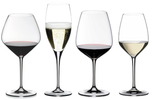
Is Riedel Crystal Or Glass? The Truth About Riedel Wine Glasses


Two hundred fifty years and eleven generations of creative and enterprising people made Riedel Crystal one of the most sought-after grape varietal-specific wine glass companies worldwide.
The family’s history of glass production and trading started with Johann Christoph Riedel (1763-1723), who traded glass items all over Europe. However, in the management of Walter Riedel (1895-11974) and the 8th generation glass genius of the family, the company started to gain prestige as the leading manufacturer of glass jewelry and crystal ware.
Even after the war, the family company continued to flourish with the help of the Swarovski family. After being in Czechoslovakia for a long time, they returned to Austria and started making hand-blown glassworks.
The real breakthrough for the company that shaped its future was the genius of the 9th generation Riedel, Claus Josef (1925-2004). He decided to break away from the traditional colored and cut glass to create plain, thin, stemmed wine glasses. The “Sommeliers” became the trademark design of Claus which was the first line of varietal-specific wine glasses.
Maximilian Josef (11th generation Riedel), present CEO and president of Riedel Crystal in 2013, worked on the stemless “O” glassware series that revolutionized how we look at wine glasses. Years before he ascended to leadership, he brought honor with the prestigious awards that the O series has amassed from 2005 to 2011.
Depending on the glass you are asking for, the answer is both yes and no.
The more costly series of Riedel, such as the Sommelier, Vitis, Vinum, Vinum Extreme, and Vinum XL, and the Wine series are made of crystal. The Sommelier Series are all handcrafted and mouth-blown crystals from Austria. The Vitis, Venum, and Wine series are machine-blown crystal wine glasses made in Germany.
The non-crystal wine glasses are the stemless O series and the long-stemmed Restaurant Degustazione, Restaurant Riedel, Restaurant XL, Restaurant O, and Restaurant Swirl. These were all designed using the same craftsmanship and genius as the crystal wine glasses. Additionally, they were made sturdy to withstand the busy and demanding restaurant environment.
Unfortunately, the Restaurant series is available only for foodservice and restaurant clients. On the other hand, you can enjoy the O series at home as it is available in individual or sets.
For those who are concerned about lead in crystal glasses, Riedel has no longer sold lead crystal glassware since 2015. They opted for borosilicate to achieve the same brilliance and luster as the lead crystal.
The company is very transparent about the kind of glasses they put into the market, conducting their research and testing procedures to achieve the best quality glassware.
Riedel makes both crystal and non-crystal wine glasses depending on the series and the price range. However, it is worth noting that the crystal glasses are not lead crystals. Instead, the company uses borosilicate that is non-toxic and is heat-resistant. It also doesn’t crack easily, making it a sturdy everyday wine glass.
If you want unique tips to glam up your home bar, check out this article on how to repurpose broken or old wine glasses.
When did Reidel stop using lead in their crystal wine glasses? How would I know if mine that I’ve had for at least 10 years are lead free? Thank you
Although I have been using your glasses for years the article was very enlightening. It’s always nice to know one has made a very wise choice. I only have on hand about 500 bottles of great wine. You can trust that all will be served in your glasses. As it has been said, there are many variables that a effect the taste of wine: the vintage, terroir, people with whom one is drinking, the purpose of the event, the atmosphere and I’ve always considered the vessel used for drinking to be one as well . Viva Reidel!

